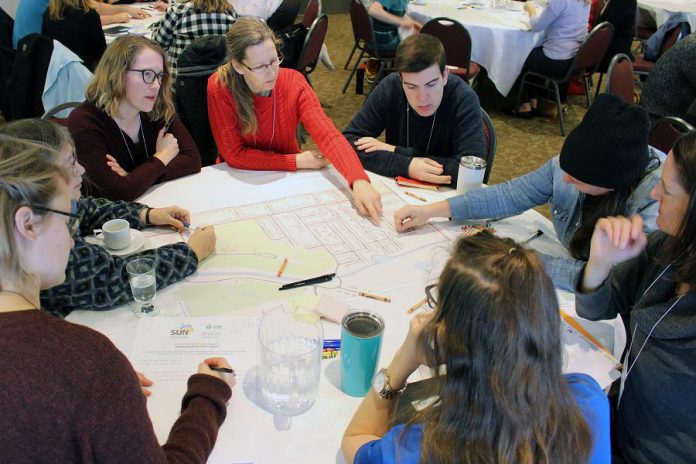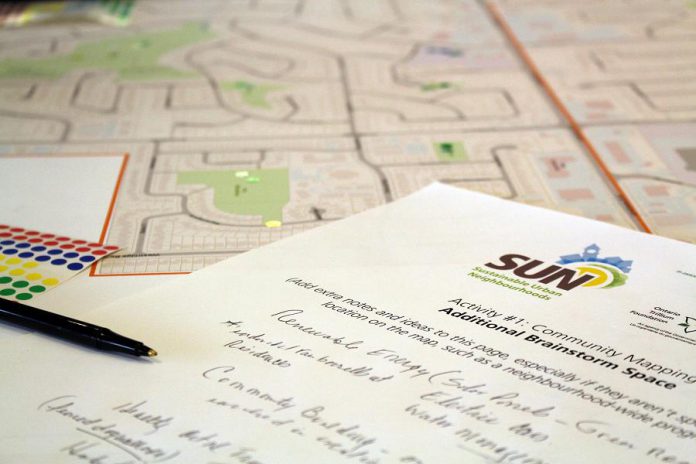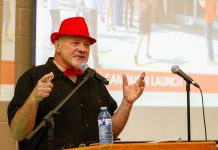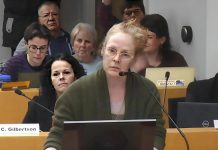
GreenUP’s Sustainable Urban Neighbourhoods (SUN) program invites Warsaw residents to join us as we explore how to conserve and protect water in Warsaw and create a Warsaw Water Action Plan.
This action plan will help area residents, businesses, local municipalities, and other stakeholders reduce the risks of flooding, protect water quality, and preserve the unique Indian River watershed.
On Wednesday, January 29th, the SUN team welcomes the Warsaw community to have their say at the Warsaw Water Gathering.
The event will be held from 5 to 8 p.m. at the Township of Douro-Dummer municipal office (894 South St., Warsaw) and is a drop-in style event featuring free food and activities for the whole family. More information is available at greenup.on.ca/event/warsaw-water-gathering/.
Those unable to attend may also complete an online survey available at greenup.on.ca/warsaw until Friday, January 31st.
The Warsaw Water Action Plan will be released in the spring of 2020 and is intended to be a guiding document for decision-making in the future.
Participatory planning involves residents of the local community

Neighbourhood planning through programs like SUN is a key piece of the puzzle when building a community that is more resilient to climate change.
The SUN program uses an approach that is called participatory planning — or co-design — because everyone contributes ideas and priorities for their own community. The SUN model is based on and delivered in partnership with the Sustainable Neighbourhood Action Plan (SNAP) program from the Toronto and Region Conservation Authority.
“Neighbourhood planning allows for urban renewal solutions that are customized to respond directly to residents’ interests and priorities and local environmental conditions,” explains Adriana Gomez, senior program manager with the SNAP program.
In other words, plans that are tailored to the specific needs of a neighbourhood are more likely to resonate with the community than a one-size-fits-all approach. Planning at the neighbourhood or community level brings people together to share ideas, resources, and energy. It is easier to get involved when your friends and neighbours are tackling a local issue together.
As Gomez points out, “residents feel pride in working for their own community.”
Changes at the neighbourhood level can also impact the wider urban environment, which helps the township, the conservation authority, and other stakeholders reach their long-term targets efficiently.
Local impacts and benefits of a water action plan for Warsaw
SUN Warsaw is the first time these collaborative programs will be piloted within an urbanizing rural community. This pilot project will demonstrate how a water action plan can benefit a rural community now and for years to come.
Unlike larger municipalities such as Toronto or even the City of Peterborough, urbanizing rural communities and municipalities like Warsaw are often not able to provide the necessary resources for climate change action.
Often, smaller municipalities are left with few options other than installing grey infrastructure (pavement, pipes, and storm drains) that other municipalities are finding insufficient as mitigation against flooding and degrading water quality. With fewer resources, rural communities such as Warsaw are increasingly vulnerable to the impacts of climate change.

The Warsaw community is well-positioned to take full advantage of GreenUP’s strong partnerships with the Township of Douro-Dummer, the County of Peterborough, and the Otonabee Region Conservation Authority, all of which currently support the SUN project through an advisory committee.
To demonstrate how these collaborative projects can become a reality, SUN has been breaking ground and creating a number of quick-start projects.
In Warsaw, SUN has already installed 218 square metres of planted shoreline at the Warsaw Community Centre and a rain garden at the municipal office. This is the equivalent area of half of an NBA-sized basketball court. An additional 282 square metres will be planted in Warsaw in 2020.
These projects demonstrate how local actions can reduce flood risk and protect water quality. For example, plants along shorelines help to reduce erosion, filter pollutants before they reach waterways, and provide habitat for fish and other aquatic animals.
Rain gardens reduce the runoff of pollutants into waterways by giving the water from rooftops or roads a place to go, where it can be slowly absorbed by the plants within the garden. The rain garden that SUN has already installed at Warsaw’s municipal office will absorb up to 170,000 litres of water annually — the equivalent volume of 110 hot tubs.
The environmental and economic benefits of the Indian River are important to Warsaw and area. The river is the beating heart of the community and the unique Warsaw Caves Conservation Area, with 30,000 visitors per year attracted to the old growth hardwood forest, unique limestone features (potholes, kettles, caves, and gorge), and shallow soils that define this conservation area.

The Indian River also provides habitat for various species at risk in Ontario, including the common nighthawk and monarch butterfly, and the federally at-risk painted turtle. An estimated 200 bird species nest in or migrate through the Warsaw area.
The RBC Foundation has generously provided funding to bring the SUN program to Warsaw for one year, with a particular focus on sustaining watershed health in the community. Warsaw is the first rural neighbourhood to pilot the SUN program.
Don’t live in Warsaw? Connect with GreenUP programs in your neighbourhood or get in touch to express interest. In the City of Peterborough, SUN has already created action plans uniquely tailored to the needs and priorities of the Kawartha Heights and East City-Curtis Creek neighbourhoods.
NeighbourPLAN is another GreenUP initiative supporting residents in the co-design of public spaces in three diverse Peterborough neighbourhoods.
For more information on SUN and its upcoming events, visit greenup.on.ca/sun/ or contact SUN program coordinator Jenn McCallum at jenn.mccallum@greenup.on.ca or 705-745-3238 ext. 208.


























